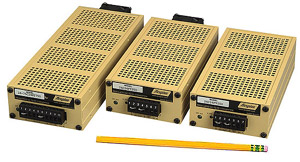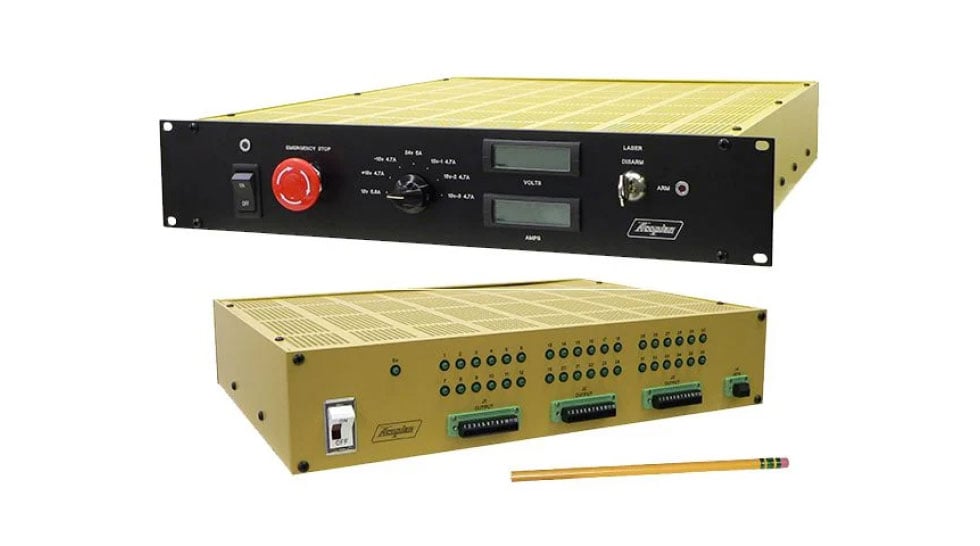Application Notes

DC-DC Converters
 DC-DC converters are power supplies that convert one DC voltage to another DC voltage. They can be step up converters or step down converters. A step-up converter provides an output voltage higher than the input voltage, while a step-down converter provides an output voltage lower than the input voltage. DC-DC converters regulate the output voltage using a complex high frequency switching technique that employs pulse width modulation and feedback. Acopian DC-DC converters, available in step-up and step-down versions, also employ extensive EMI filtering and shielding to attenuate both common and differential mode noise conducted to the line and load. Galvanic isolation is standard in our converters, affording our users input to output and output to ground isolation for maximum versatility.
DC-DC converters are power supplies that convert one DC voltage to another DC voltage. They can be step up converters or step down converters. A step-up converter provides an output voltage higher than the input voltage, while a step-down converter provides an output voltage lower than the input voltage. DC-DC converters regulate the output voltage using a complex high frequency switching technique that employs pulse width modulation and feedback. Acopian DC-DC converters, available in step-up and step-down versions, also employ extensive EMI filtering and shielding to attenuate both common and differential mode noise conducted to the line and load. Galvanic isolation is standard in our converters, affording our users input to output and output to ground isolation for maximum versatility.
Do Acopian DC-DC converters require a minimum load for proper regulation?
All Acopian DC-DC converters are internally pre-loaded. Output voltage regulation will be within specifications from 0% load to 100% load.
What is a wide adjust output?
Typical converters have a fixed output voltage with an adjustable range of ± 0.5volts. Wide adjust DC-DC converters are continually adjustable over the whole output range, from 0 volts to rated output voltage. Acopian makes DC-DC converters in both styles, with our low profile switched mode wide adjust DC-DC converter having an output voltage and current adjustable with an internal screwdriver pot or an external 0-10VDC or 0-5VDC signal. Options are available for remote adjustment through an Ethernet, RS232, or USB connection.
Does Acopian manufacture a current regulated converter?
Yes, Acopian’s low profile wide adjust DC-DC converter can be used in voltage regulation or current regulation mode. Typical converters are voltage regulated, which means that the output voltage will remain constant throughout the output current range. Acopian’s low profile wide adjust converters can be voltage regulated or current regulated, depending on the load and power supply settings. For example, imagine a 10VDC, 5A DC-DC converter with a connected load that draws 3A at 10V. If the Vadj and Iadj pots are fully clockwise, the converter will regulate the voltage at 10VDC and the output current will be 3A. If the Vadj pot is slowly turned counterclockwise, the output voltage will track the pot setting. If it is left at 5VDC, the output will remain at 5VDC and the current will be reduced to 1.5A. Current regulation mode is different. Leave the Vadj pot fully clockwise and turn the Iadj pot counterclockwise. When the Iadj reaches 3A, the power supply will start to current regulate. As the Iadj pot is turned lower, the output voltage will start to decrease to maintain the current that the Iadj pot is set at. If it is left at 2A, the output current will remain at 2A, the output voltage adjusting to the voltage required to keep it at 2A (6.7V in this case).
Does Acopian manufacture a programmable converter?
Yes, Acopian’s low profile wide adjust converter can be remotely programmed. Wide adjust converters typically have adjustment potentiometers (pots) mounted on the power supply to adjust the output voltage and current. Acopian’s low profile wide adjust converters can also be programmed remotely. Our standard units can be remotely programmed with a 0-10VDC external programming voltage (0-5VDC optional). That means that the output voltage and current can be remotely “set” by an analog output from a PLC, computer, or other control device. Our 1U and 1400Watt units can also be remotely programmed using Ethernet, RS232, or USB interfaces. This means that the user interface can set the output voltage, output current, and converter enable. Also, the output voltage, output current, and converter status can be monitored through this interface.
Can converters be paralleled for a higher current output?
Acopian’s low profile converters, when ordered with the “P” option, can be paralleled for a higher output current. Up to four units can be connected in parallel to obtain a maximum 2880 watts. Through Acopian’s unique “Sbus” connection, the power supplies will actually share current.
Can converters be connected to provide a redundant output?
Acopian’s low profile DC-DC converters, when ordered with the “N” option, can be connected (up to four units) for an N+1 redundant output. N+1 redundancy means that there is one more converter connected than the load actually requires, and that even with the loss of one converter, the load will continue to function normally. For example, if a load requires 15A to operate properly, connect four (4) 5A converters in parallel. If one converter fails, there will still be 15A available.
Mini Encapsulated DC-DC converters
- Various models with DC inputs from 5VDC to 48VDC 7 – 14 Watts
- Screw terminals or PC mounting
- Short circuit and overload protected
- Single output or dual tracking
Narrow Profile DC-DC converters
- Models with input ranges: 18-36VDC, 36-75VDC, 18-75VDC, 110-350VDC
- 54 – 288 Watts
- Short circuit and overload protected
- Overvoltage protection
- Pluggable input/output terminal block
- Internal EMI filter and RFI shielding
- 110-350VDC input range
- 450 -720Watts
- Fixed and wide-adjust models
- Short circuit and overload protected
- Overvoltage protection
- Pluggable input/output terminal block
- Constant current and constant voltage modes (wide adjust output models)
- Programmable (Vout, Iout, Vmon, Imon, Vok, enable) (wide adjust output models)
- Analog (0-10VDC)
- Ethernet
- RS232
- USB
- Parallelable (fixed voltage models) – up to 2880 Watts
- Internal EMI filter and RFI shielding
- Soft start
- 30 – 60 Watts
- 21.6 – 32VDC input range
- Wide adjustable output
- Up to 30KV available
- Soft start

 Made In The USA
Made In The USA

